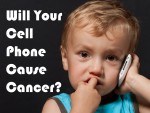 Surveys find most people don’t realize that, according to manufacturer recommendations, their cell phones should be kept between .3″ and 1″ inch away from their body at all times. I’m not “most people.”
Surveys find most people don’t realize that, according to manufacturer recommendations, their cell phones should be kept between .3″ and 1″ inch away from their body at all times. I’m not “most people.”
As a Consumer-Investigative Reporter, I’ve covered far too many stories about the dangers of cell phone radiation (accusations the industry denies). Yet, I still let my 2-year old play with my cell phone, and it sits on our nightstand just feet from her crib.
You may have heard that the city of Berkeley, CA, has become the first in the nation to require cell phone retailers to post a warning about the dangers of cell phone radiation.
More specifically, they have to post the following warning, directing consumers to the fine print that already comes with their phone:
To assure safety, the Federal Government requires that cell phones meet radio frequency (RF) exposure guidelines. If you carry or use your phone in a pants or shirt pocket or tucked into a bra when the phone is ON and connected to a wireless network, you may exceed the federal guidelines for exposure to RF radiation. This potential risk is greater for children. Refer to the instructions in your phone or user manual for information about how to use your phone safely.
Last week when I was covering the story, I interviewed one of the foremost experts on (and critics of) electromagnetic radiation.
During the interview I asked him a personal aside:
“How dangerous is it that I keep two cellphones and a wireless baby monitor in our bedroom where my child sleeps?”
(Yes, her crib is still in our bedroom, but that’s a topic for another blog.)
As a result of his response, I came home that night, removed the baby monitor from our bedroom, asked my husband to track down our old alarm clock and declared our bedroom a wireless-free zone (i.e. no cell phones or wireless devices of any kind)!
Needless to say, my husband was not pleased with my decision to ban cell phones from the bedroom, but he reluctantly agreed to keep our phones charging in the kitchen at night.
Here is Dr. Moskowitz’s response to my question, edited down to about two minutes.
Brain tumors, what?!?
Joel M. Moskowitz, Ph.D., is the Director of the Center for Family and Community Health at the School of Public Health at the University of California, Berkeley. He is also among the 190 international scientists who signed this letter asking the United Nations, the World Health Organization and others to warn the public about the true dangers of electromagnetic radiation (or “electromagnetic fields” aka EMF).
They liken the cell phone industry to Phillip Morris and contend years from now we’ll be talking about how this industry swore that cell phone radiation wasn’t harmful either.
In its response for my TV news story, the CTIA said that the scientists and the City of Berkeley were sending an “alarmist message that is unsupported by the best available science.” They cite these reports from the FDA, the FCC and even my station’s sister website CNET.
For his part, Moskowitz cited over 2,000 peer-reviewed studies that link cell phone radiation to adverse health effects, including tumors, infertility, developmental delays and more. He even cited a current study examining the link between Autism and EMF exposure during pregnancy and adolescence. (Yep, he dropped the “A” word!)
Now, as a reporter, I am exposed to “a new study” almost every day that warns me some seemingly benign product in my home will eventually kill me or my child. I’ve admittedly become callous to them (though I know the sheer volume of these warnings must have a subliminal effect on me).
Boldly declaring our bedroom a wireless-free zone was not solely due to the warnings of Dr. Moskowitz and 189 of his scientist friends.
My decision to ban cell phones from the bedroom was based, in part, on a conversation I had years ago with an executive at a major cell phone company.
She and I sat on a panel together. Afterward, we began talking about trying to get pregnant, and somehow the topic of cell phones in the bedroom came up.
She told me casually that the engineers at her company had warned her not to sleep with her cell phone in her room. As a result, this cell phone company executive said she kept her phone charging in the bathroom at night.
You might think her comment would have had an impact on me then, but alas, I am a creature of convenience. For years, I’ve continued to keep my phone on my nightstand. It’s my alarm clock, my note pad, my right hand; I even used to log my daughter’s nursing and sleep patterns as she slept just inches away.
Ironically, after countless stories and several years, it was a city ordinance in one of the most liberal cities in the country that triggered that memory and motivated me to finally make the change. (It could also be the fact that I’m now responsible for another human life.)
Now let’s be clear, I am not advocating for the anti-wireless groups. I am not a scientist nor do I contend that my decision is the right decision for every family. I am simply sharing how what I’ve learned as a reporter has affected my life as a mother (the premise of the #NewsMom Blog).
Will my cellphone harm me or my child? Probably not. Even Moskowitz points out that not every smoker gets lung cancer.
I’m not going to wrap my kid in tin foil, and there is clearly no way to eliminate her exposure to EMF. She’ll likely grow up with Wi-Fi in school.
However, there are some things I know I can do to help reduce her exposure because …. what if the scientists are right?
- I can be more diligent about putting my cell phone in “airplane mode” whenever my daughter is watching videos or playing with apps on it.
- I’ve already begun trying to teach her that “we don’t hold phones to our ears, we use the speaker or wired ear buds” (though that’s going to take some deprogramming, as my husband and I walk around with our phones glued to our ears).
- When she’s old enough to have a phone of her own, I plan on requiring that she use devices like these that are specifically designed to prevent kids from touching the phone to their heads (per cell phone manufacturer warnings).
NOTE: These are not radiation-blocking cell phone cases, which come with their own set of concerns.
Fast forward nearly one week after boldly declaring our room wireless free, and I can tell you that it is harder than I thought.
Reducing my child’s nightly eight-hour exposure to EMF is helping me sleep a little bit better. However, my husband and I have spent more time than I’d like to admit standing in the kitchen late at night answering texts or emails. We’ve both caught each other breaking the no-phone-in-the-bedroom rule.
On the bright side, instead of sitting in bed browsing Facebook, twice this week I’ve walked into the bedroom to find my husband reading The Economist!
Maybe change can be good.
UPDATE: June 8, 2015 – CTIA – The Wireless Association filed a law suit against the City of Berkeley stating the ordinance violates the First Amendment.
“Berkeley’s Ordinance plainly violates the First Amendment. The ordinance also unlawfully interferes with FCC regulations and contradicts the federal government’s determination—based on extensive scientific evidence—that cellphones approved for sale in the United States do not pose a public health risk. It is unconstitutional to force cellphone retailers to communicate false, misleading and inflammatory information about their products. It is unfortunate that Berkeley would incite unfounded public anxiety and fear about a product that is so important to its citizens’ everyday lives.”
UPDATE: August 28, 2015 – CTIA – The Wireless Association Lost its law suit against the City of Berkeley
“U.S. District Judge Edward Chen, citing Federal Communications Commission research, upheld the city ordinance to require sellers to inform customers that keeping a device in a pocket or bra could lead to radiation exposure that exceeds federal guidelines. Chen concluded there was “a reasonable scientific basis” to believe that such emissions “at some levels can and do present health risks.” The judge, however, disallowed a warning that children could be at greater risk, noting that it remained a “matter of scientific debate.” Source: San Francisco Canonical#NewsMom Bonus Stories:
What about wireless baby monitors?
Dr. Moskowitz “weighs in” in this follow up post.
“A Wireless-Free Bedroom – Just the Beginning?”
Will your cell phone cause cancer?
Consumer Reports weighs in on the debate.
For more editorials and blogs like this, check out:
Featured Blogs & Reviews feed on NewsMom.com.




Do you have any input or thoughts/reviews on the phone cases that are supposed to reduce radiation exposure – i.e. Pong, SafeSleeve, Defender, etc.? I’m case shopping now and looking for objective input! Thank you!
Hi, stay tuned! I passed your question on to one of my experts on the topic. NOTE: We don’t endorse products, but I’ve asked him for some feedback on what to look for in these types of products.
These two posts on the EMR Safety web site pertain to EMF blocking cell devices.
Buyer Beware: Cell Phone Radiation-Reducing Products
http://www.saferemr.com/2015/01/buyer-beware-cell-phone-radiation.html
Cell Phone Cases Can Increase Radiation Exposure
http://www.saferemr.com/2015/03/cell-phone-cases-can-increase-radiation.html
According to Dr. Moskowitz, although some cell phone cases have been subjected to SAR testing in independent labs, he suspects the SAR test does not provide a good simulation of how people use cell phones (or who uses them). Moreover, the SAR level may not even be a valid measure of the potential harm that a cell phone can do to you.
One of the companies you mention in your questions solicited his input several years ago. The case supposedly redirects radiation away from the user. However, Moskowitz says he sent the manufacturer a list of follow-up questions, but they refused to answer them unless he signed a nondisclosure agreement. For example, if the nearest cell tower is on the opposite side of your body from where the phone is located will the phone boost its output to compensate?
Moskowitz posed your question to a science writer for us who has researched the biological effects of non-ionizing radiation for several decades. Here is her answer …
“I get questions like the one below all the time, especially this time of year. I usually answer that shielding products for phones usually force the phone to up its signal which can create a stronger exposure. Some cases shield only against the head but — and this is a BIG ‘but’ that few know about — cell phones work best when they enlist brain tissue and the entire body as part of the transmission. Even blocking it that way against the head can boost the signal, especially to hands, arms, neck, etc. And anyone who shields a phone and then texts can potentially direct stronger signals right into the eyes and brain via ocular nerves. Plus, the newer iPhones et al have multiple antennas now. Such shielding tactics are really ruses to make people feel like they are protecting themselves but in fact can make exposures worse, especially in those nearby in the path of a boosted signal.”
Bottom line is that phones need clear access to infrastructure to work. Anything that impedes can just complicate that…
See the EMR Safety tip sheet for recommendations on how to reduce wireless radiation exposure: http://bit.ly/saferemrtips3.
Bottom line, limit exposure… which I realize is totally easier said than done for most of us!